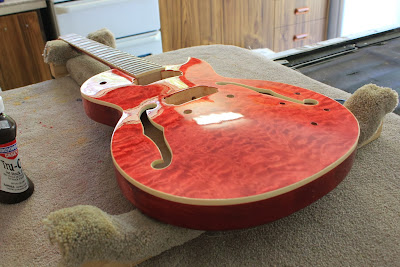For my Les Paul Florentine project, the
Pit bull ES-2T kit came with the option of a fixed or floating bridge. Since I am after a fixed tune-o-matic bridge, it was up to me to install the bugger - including finding its proper location and drilling the holes for the bridge posts. For anyone who is interested in how to do this, here are the steps I take to do a tune-o-matic bridge installation.
Step 1. Mask off the body and Extend Neck Line: To make sure your measuements and line marking doesn't impact the body of your guitar, first mask it off with painters tape. Then, using your ruler, mark lines on the tape extending the line of your neck down past the bridge pickup cavity.
Step 2. Measure the Scale Length & Calculate Bridge Post Position: As we all know, the bridge must be positioned correctly (witin 1-2mm) so that correct intonation can be achieved in each of the 6 strings. The correct position of the bridge posts, on both the treble and bass sides, is determined by the scale-length of the neck +- some
compensation for each string that takes into account string gauge and so on.
The scale length of a guitar neck is equal to twice the distance from the fret side of the nut to the very middle of the 12th fret. On my guitar, as on many Les Paul style kits, the distance to the 12th fret is 313mm, giving a total scale length of 626mm. Once the scale length is known, to find the position of the bridge posts it is a simple matter of consulting the
Stewmac Fret Position Calculator. For a 22 fret neck with scale length 626mm and tune-o-matic bridge, Stewmac tells us that:
"From the nut to Treble Side Post should be 627.534mm, and that we should allow another 1.5mm to 3mm further on the Bass side post".
Step 3. Measure Bridge Post Position and String It Up: Once the bridge post positions are known, it is a relatively simple task to measure the distance from the nut and mark each position off on the tape (across the neck line we drew). For the bass-side post, I tend to measure into the middle of the suggested range (adding in this case 2mm to the treble side distance).
Once the posiiton is known length-wise, we need to locate the bridge posts across the body - ie. with respect to the neck and the tailpiece so that the E strings are positioned correctly up the neck. The easiest way to do this is to string the guitar up with the two E strings and pass them over the bridge (that is sitting flat on the body). If the strings are touching the frets, then washers can be used to raise the bridge off the body until the strings sit off.
The bridge is then moved side to side until the correct string placement up the neck is achieved.
Step 4. Mark the Post Holes: Once you have the position of the bridge just the way you want it, you need to mark the position of each hole ready for drilling. It is important that the correct location of the posts is maintained through this process, and the best way to ensure this is to use a set of
transfer punches to mark each position.
Select a punch which is the largest possible that still fits through the hole in the bridge, and then tap lightly with a hammer to mark the center of the hole. Make sure the bridge doesn't move when you tap that first hole!
Step 5. Measure Depth and Drill Test Hole: With the locations for each post marked with the punch, you can move on to drilling the post holes. To minimise gauge-out around the edges of the holes, I recommend using a brad-point drill bit. I bought an imperial set from Stewmac and they have been my best tool investment yet. However, before you reach for the drill, you should measure the required depth of the post holes, mark this distance on the drill bit using some tape, and drill a test hole to make sure you have the correct drill bit size.
Step 6. Drill..!: Once you are satisfied that everything is correct, you can go ahead and drill your holes in the guitar top. Try to hold the drill as straight as possible in both directions (or better still use a drill press). Drill down to the indicated depth only and make sure all the crap has been cleaned out of the holes.
If you use a brad-point drill bit as suggested, you should end up with nice clean post holes like mine!
Step 7. Tap in the Posts: After you've successfully drilled the post holes, all that remains is to test-fit the posts and the bridge. To do this you simply tap them in using some wood to even out the force and protect the bridge's finish.
I usually do this step on both posts simultaneously, with the bridge fitted to make sure the posts go in straight and still allow the bridge to sit astride them once fully seated. But that's just me - paranoid about everything!
And viola! There you have it - a tune-o-matic bridge fitted to your guitar with the correct placement, taking into account correct comensation and the like. Of course we have made use of expertise from those nice folks at Stewmac, but hey - no point re-inventing the wheel!


































